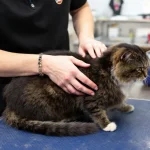Certainly! Here are 18 tips for homemade cat food, cat trees, and cat toys:
Homemade Cat Food:
- Consult with a Veterinarian: Before making homemade cat food, consult with a veterinarian or veterinary nutritionist to ensure it meets your cat’s nutritional needs.
- Balance Nutrients: Ensure your homemade cat food includes a balance of protein, fats, vitamins, and minerals essential for your cat’s health.
- Quality Ingredients: Use high-quality, human-grade ingredients in your cat’s food, including lean meats, vegetables, and supplements as recommended by your veterinarian.
- Cook Thoroughly: Cook meat thoroughly to kill any potential pathogens that could harm your cat.
- Avoid Harmful Ingredients: Avoid using ingredients toxic to cats, such as onions, garlic, grapes, raisins, chocolate, and xylitol.
- Proper Storage: Store homemade cat food properly in airtight containers in the refrigerator or freezer to prevent spoilage.
Cat Trees:
- Sturdy Base: Ensure the base of your homemade cat tree is sturdy and stable to prevent tipping over.
- Natural Materials: Use natural materials like wood branches, sisal rope, and carpet remnants for scratching posts and perches.
- Multiple Levels: Create multiple levels and platforms at different heights to encourage climbing and lounging.
- Secure Components: Secure all components of the cat tree firmly to prevent accidents or injuries.
- Entertainment: Attach toys, feathers, or dangling strings to the cat tree to provide entertainment and stimulation for your cat.
DIY Cat Toys:
- Safety First: Use safe materials and avoid small parts that could be swallowed or cause choking hazards.
- Catnip Fun: Incorporate catnip into homemade toys to make them more enticing for your cat.
- Variety is Key: Provide a variety of toys with different textures, shapes, and sounds to keep your cat engaged.
- Interactive Play: Engage in interactive play with your cat using homemade toys to strengthen your bond and provide mental stimulation.
- Repurpose Household Items: Repurpose household items like cardboard tubes, paper bags, and old socks to create simple and inexpensive cat toys.
- Rotate Toys: Rotate your cat’s toys regularly to keep them interested and prevent boredom.
- Supervision: Always supervise your cat when playing with homemade toys to ensure their safety and prevent accidental ingestion of non-food items.
By following these tips, you can provide your feline friend with homemade cat food, trees, and toys that are safe, stimulating, and enjoyable.






